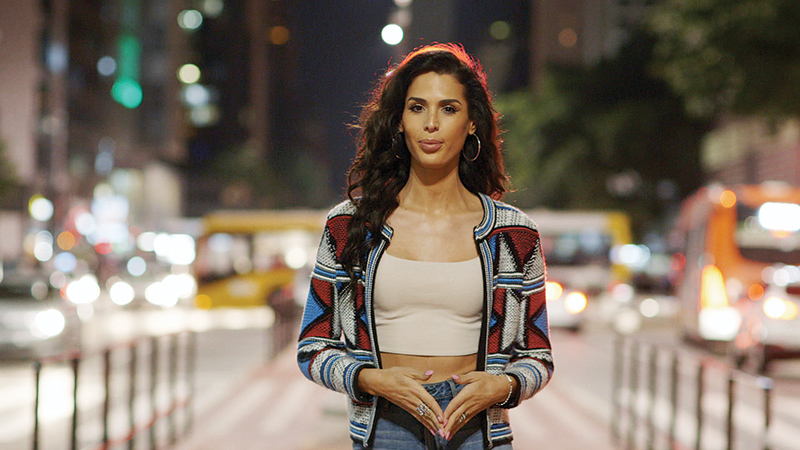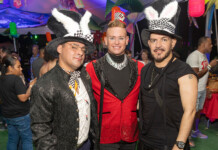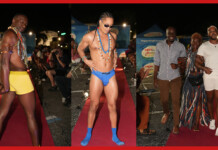¿Dónde demonios está Carmen Carrera?
La estrella de ¨Drag Race¨ ha cambiado de hombre a mujer después del show – ahora, ella está ayudando a la transición mundial también
Por Chris Azzopardi
Carmen Carrera se llama a sí misma una persona “cambiada” después de competir en la tercera temporada de “RuPaul’s Drag Race” en 2011. Tras su paso por el espectáculo, la modelo puertorriqueña-peruana cambió de hombre a mujer y ahora utiliza su propia experiencia como transgénero para inspirar a otros que están luchando con su identidad de género.
Para cumplir con su misión de destacar los asuntos trans en el extranjero, Carrera viajó recientemente a São Paulo, Brasil, para un episodio de la serie “Outpost” por Fusion, que mina mundialmente resonantes historias humanas, sociales y culturales. Aquí, ella habla de la experiencia de abrir los ojos, así como aquellos que todavía la consideran una “broma”.
De ¨Drag Race¨ a activista
“Drag Race” fue un momento en mi pasado – quería hacer ese show porque sabía que después del show iba a la transición, por lo que, para mí, siempre va a ser una cápsula del tiempo en mi vida. Y honestamente, he crecido tanto como una persona desde entonces. La comunidad de “Drag Race” me conocía desde la escena del club. Tengo ahora 31 años. Soy una esposa. Soy una madrastra. Todavía soy muy divertido (risas), pero soy mucho más responsable de lo que nunca he sido, y también estoy feliz por ello. Me veo a mí misma como una mujer trans muy privilegiada; Soy capaz de experimentar lo que se siente al tener amor y tener hijos y trabajar y sobrevivir, así que me siento como en ese sentido he cambiado mucho. Ahora, me veo en un lugar totalmente diferente y quiero ser capaz de (decir)a la gente trans, “Tienes más posibilidades de lo que te das cuenta”.
Activismo global para la comunidad trans
Empecé un viaje para contribuir con mi activismo comunitario fuera de los Estados Unidos. Quería tomar las mismas cosas que aprendí aquí de gente como Laverne (Cox), Janet (Mock), Caitlyn (Jenner) y Jenna (Talackova) y volver a mis raíces para volver a Sudamérica y Centroamérica Y tratar de ser un activista. Así que empecé con México, donde me permitieron traer básicamente asuntos trans a las estaciones de noticias mexicanas. Pude sacar eso a la luz. Hice lo mismo en Columbia y me reuní con organizaciones LGBTQ en esos países para realmente traer información a sus principales medios de comunicación.
El precio de vivir en voz alta
Sólo siendo una mujer trans, la gente no me toma tan en serio como debería. He leído los comentarios, que probablemente no debería, pero lo hago. Y es una lástima, pero no es mi responsabilidad cambiar la mente de todos. Uno sólo tiene que dar el ejemplo, es necesario poner en el trabajo. Soy una mujer trans, pero ya sabes, puedo modelar, puedo actuar, puedo ser un activista. Poco a poco, la gente comenzará a entender eso y no me tomará tanto como una broma.
Continuación de la sensibilización sobre cuestiones LGBTQ a nivel internacional
Estoy trabajando en Venezuela y Chile, tratando de ver si puedo conseguir una compañía de producción o una red para ayudarme a tomarme en el camino y explorar otras ciudades y otros países y sus leyes LGBT. Básicamente, quiero ver dónde estamos en una escala global. Tengo un montón de fans en Brasil, así que quiero ser capaz de seguir alimentándolos con la inspiración que necesitan. Quiero decir, si hay 2,5 millones de personas que aparecerán para una celebración de orgullo gay, no entiendo por qué unos doscientos de miles no pudieron presentarse para exigir derechos iguales o leyes de protección, así que espero que ellos se encarguen de mejorar sus propias vidas.
Próximos pasos: traer la historia LGBTQ al aula
Tengo dos hijos en casa, de 12 y 8 años, y saben mucho sobre la historia de los LGBTQ. Yo mismo les enseñé, y ellos han visto mi transición y ellos te educarán si te sientas con ellos y les haces preguntas. Eso realmente me inspiró.
Me he encargado de vincularme con una organización que me está ayudando a crear un plan de estudios K-12 para enseñar historia LGBTQ en las aulas. Voy a enviar a cada escuela en Estados Unidos que posiblemente pueda y espero que podamos educar a nuestros hijos en nuestra historia para ayudar a romper el estigma y ayudar a iniciar la conversación en la escuela y ayudar a acabar con la intimidación y preparar mejor a nuestra juventud.
Where in the World Is Carmen Carrera?
“Drag Race” alum transitioned from male to female after the show – now, she’s helping the world transition too
By Chris Azzopardi
Carmen Carrera calls herself a “changed” person after competing on the third season of “RuPaul’s Drag Race” in 2011. Following her stint on the show, the Puerto Rican-Peruvian model transitioned from male to female and now uses her own experience as a transgender woman to inspire others who are grappling with their gender identity.
To fulfill her mission to raise trans awareness abroad, Carrera recently traveled to São Paulo, Brazil, for an episode of the Fusion docuseries “Outpost”, which mines globally-resonant human, social and cultural stories. Here, she talks about the eye-opening experience, as well as those who still consider her a “joke.”
From “Drag Race”to activist
“Drag Race” was a moment in my past – I wanted to do that show because I knew that after the show I was gonna transition, so, for me, that is always gonna be a time capsule in my life. And honestly, I’ve grown so much as a person since then. The “Drag Race” community got to know me right out of the club scene. I’m now 31. I am a wife. I am a stepmother. I’m still a lot of fun (laughs), but I’m way more responsible than I’ve ever been, and I’m happy about it too. I see myself as a very privileged trans woman; I’m able to experience what it feels like to have love and have children and work and survive, so I feel like in that sense I’ve changed a whole lot. Now, I see myself in a totally different place and I wanna be able to (tell) trans people, “You have more possibilities than you even realize.”
Going global with her trans activism
I set out on a journey to contribute my community activism outside of the United States. I wanted to take the same things that I learned here from people like Laverne (Cox), Janet (Mock), Caitlyn (Jenner) and Jenna (Talackova) and connect back to my roots, to really go back to South America and Central America and try to be an activist. So, I started off with Mexico, where they allowed me to basically bring trans issues to Mexican news stations. I was able to bring that to light. I did the same thing in Columbia and met with LGBTQ organizations in those countries to really bring information to their mainstream media.
The price of living out loud
Just me being a trans woman, people don’t take me as seriously as they should. I read the comments, which I probably shouldn’t, but I do. And it’s a shame, but it’s not my responsibility to change everybody’s mind. You just have to lead by example, you need to put in the work. I’m a trans woman, but you know, I can model, I can act, I can be an activist. Little by little, slowly people will begin to understand that and not take me so much as a joke.
Continuing to raise awareness of LGBTQ issues internationally
I’m working on Venezuela and Chile, and I’m trying to see if I can get either a production company or a network to help take me on the road and explore other cities and other countries and their LGBT laws. Basically, see where we’re at on a global scale. I have a ton of fans in Brazil, so I wanna be able to just continue feeding them the inspiration they need. I mean, if there’s 2.5 million that will show up for a gay pride celebration, I don’t understand why a couple hundred thousand couldn’t show up to demand equal rights or protection laws, so I hope that they take it upon themselves to want better.
Next steps: bringing LGBTQ history into the classroom
I have two kids at home, age 12 and eight, and they know so much about LGBTQ history. I taught them myself, and they’ve seen my transition and they’ll educate you if you sit down with them and ask them questions. That really inspired me.
I have taken it upon myself to link up with an organization who is helping me create a K-12 curriculum for teaching LGBTQ history in the classrooms. I’m gonna ship that out to every single school in America I possibly can and hope that we can educate our children on our history to help break the stigma and help start the conversation on school grounds and help end bullying and better prepare our youth.
As editor of Q Syndicate, the international LGBT wire service, Chris Azzopardi has interviewed a multitude of superstars, including Meryl Streep, Mariah Carey and Beyoncé. Reach him via his website at www.chris-azzopardi.com and on Twitter (@chrisazzopardi).













